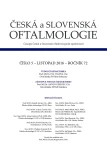The Tear Osmolarity of PATIENTS with Lagophthalmos
Authors:
A. Píšová 1; Martin Chovanec 2; J. Betka 2; K. Ferrová 1; M. Česká Burdová 1; M. Odehnal 1; D. Dotřelová 1; G. Mahelková 1,3
Authors‘ workplace:
Oční klinika dětí a dospělých 2. LF UK a FN v Motole, přednosta prof. MUDr. Dagmar Dotřelová, CSc., FEBO
1; Klinika otorinolaryngologie a chirurgie hlavy a krku 1. LF UK a FN v Motole, přednosta prof. MUDr. Jan Betka, DrSc., FCMA
2; Ústav fyziologie 2. LF UK, přednosta
prof. RNDr. Václav Hampl, DrSc.
3
Published in:
Čes. a slov. Oftal., 72, 2016, No. 5, p. 172-176
Category:
Original Article
Overview
Introduction:
Lagophthalmos can be characterized as the dysfunction of the eye aperture and in some cases even by the disruption of tear production. Dry eye syndrome can consequently develop. Instability of the tear film, hyperosmolarity and inflammatory reaction are considered as the key mechanisms of dry eye syndrome. In our report we monitored the tear osmolarity of patients with postsurgical unilateral lagophthalmos. Results were compared with tear osmolarity of the non-lagophthalmic eyes.
Methods:
We examined 10 patients (6 women, 4 men) with postsurgical facial nerve palsy and lagophthalmos complicating management of either cerebellopontine (8 patients) or salivary gland tumors (2 patients). Only patients without severe corneal defects enrolled the study. The tear osmolarity was measured in lower tear meniscus by TearLab Osmolarity System device. The lagophthalmic eye was always examined first. The results are presented as mean plus/minus the standard deviation. The paired t-test was used for statistical data processing. The p-value ≤ 0,05 was considered as statistically significant.
Results:
The mean tear osmolarity of the lagophthalmic eyes was 296 ± 15,0 mosmol/l (275–315 mosmol/l). In case of healthy eyes the mean osmolarity was 310 ± 12 mosmol/l (292–336 mosmol/l). The tear osmolarity in case of lagophthalmos was significantly lower than in the healthy eyes (p = 0,05).
Conclusion:
In contrary to the studies demonstrating higher tear osmolarity under the scenario of dry eye syndrome, we found lower tear osmolarity in the lagophthalmic eyes than in the healthy eyes. The possible reason could be the changes in tear dynamics of the lagophthalmic eye due to disturbance of eye lid function. Our results also stress the need of evaluation of the actual tear osmolarity in the view of complex clinical eye findings. The place of tear collection should also be considered.
Key words:
lagophthalmos, dry eye syndrom, tear osmolarity
Sources
1. Braun RJ, King-Smith PE, Begley CG et al.: Dynamics and function of the tear film in relation to the blink cycle. Prog Retin Eye Res 2015 Mar; 45, 2015 : 132–164.
2. Bron, J., Abelson, M., Ousler, G. et al.: The definition and classification of dry eye disease: report of the Definition and Classification Subcommittee of the International Dry Eye WorkShop (2007). Ocul. Surf, 5(2), 2007 : 75–92.
3. Bron, J., Abelson, M., Ousler, G. et al.: Methodologies to diagnose and monitor dry eye disease: report of the Diagnostic Methodology Subcommittee of the International Dry Eye
4. Dartt DA: Regulation of lacrimal gland secretion by neurotransmitter and the EGF family of growth factors. Exp Eye Res 2001; 73, 2001 : 741–752.
5. de Haas EBH: Lacrimal gland response to parasympathicomimetics after parasympathetic denervation. Arch Ophthamol, 1960; 64 : 64–73.
6. Gilbard JP, Farris RL, Santamaria J et al.: Osmolarity of tear microvolumes in keratoconjunctivitis sicca. Arch Ophthalmol, 1978; 96(4), 1978 : 677–681.
7. Lemp MA, Bron AJ, Baudouin C et al.: Tear osmolarity in the diagnosis and management of dry eye disease. Am J Ophthalmol, 2011; 151(5), 2011 : 792–798 e791.
8. Lemp MA: Advances in understanding and managing dry eye disease. Am J Ophthalmol, 2008; 146(3), 2008 : 350–356.
9. Liu H, Begley C, Chen M et al.: A link between tear instability and hyperosmolarity in dry eye. Invest Ophthalmol Vis Sci 2009; 50(8), 2009 : 3671–3679.
10. Murube J.: Tear osmolarity. Ocul Surf, 2006; 4, 2006 : 62–73.
11. Murube J.: Basal, reflex, and psycho-emotional tears. Ocul Surf 2009;7, 2009 : 60-66.
12. Salvatore MF, Pedroza L, Beuerman RW: Denervation of rabbit lacrimal gland increases levels of transferrin and unidentified tear proteins of 44 and 36 kDa. Curr Eye Res, 1999; 18, 1999 : 455–466.
13. Stahl U, Willcox M, Stapleton F: Osmolality and tear film dynamics. Clin Exp Optom, 2012; 95, 2012 : 3–11.
14. Stern ME, Beuerman RW, Fox RI, Gao J, Mircheff AK, Pflugfelder SC. The pathology of dry eye: the interaction between the ocular surface and lacrimal glands. Cornea, 1998; 17(6): 584–589.
15. Stern ME, Gao J, Siemasko KF: The role of the lacrimal functional unit in the pathophysiology of dry eye. Wxp Eye Res, 2004;78, 2004 : 409–416.
16. Tomlinson A., Khanal S, Ramaesh K et al.: Tear film osmolarity: determination of areferent for dry eye diagnosis. Invest Ophthalmol Vis Sci, 2006; 47(10), 2006 : 4309–4315.
17. Toshida H, Nguyen DH, Murakami A et al.: Evaluation of novel dry eye model: preganglionic parasympathetic denervation in rabbit. Invest Ophthalmol Vis Sci, 2007; 48, 2007 : 4468–4475.
18. Vásquez LM, Medel R: Lagophthalmos after facial palsy: current therapeutic options. Ophthalmic Res. 2014;52(4), 2014 : 165–9.
19. Versura P, Campos EC: TearLab osmolarity system for diagnosing dry eye. Expert Rev Mol Diagn, 2013;13, 2013 : 119–129.
20. Versura P, Profazio V, Campos EC: Performance of tear osmolarity compared to previous diagnostic tests for dry eye diseases. Curr Eye Re,s 2010; 35(7), 2010 : 553–564.
Labels
OphthalmologyArticle was published in
Czech and Slovak Ophthalmology

2016 Issue 5
Most read in this issue
- Blepharophimosis-ptosis-epicanthus inversus syndrome
- Iris melanoma in a child
- Preimplantation genetic diagnosis and monogenic inherited eye diseases
- The Tear Osmolarity of PATIENTS with Lagophthalmos
